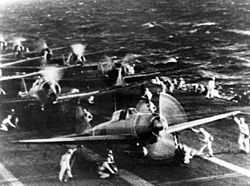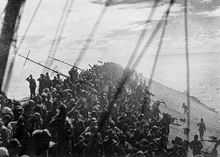Shōkaku-class aircraft carrier
 Shōkaku at Yokosuka, 23 August 1941, shortly after she was completed | |
| Class overview | |
|---|---|
| Name: | Shōkaku-class aircraft carrier |
| Builders: |
Kawasaki Kobe yard Yokosuka Naval Arsenal |
| Operators: |
|
| Preceded by: | Hiryū |
| Succeeded by: | Taihō |
| Built: | 1938–41 |
| In commission: | 1941–44 |
| Completed: | 2 |
| Lost: | 2 |
| General characteristics | |
| Class and type: | Shōkaku-class aircraft carrier |
| Displacement: | 25,675 long tons (26,087 t) (standard) 32,000 long tons (33,000 t) (full load) |
| Length: | 257.5 m (844 ft 10 in) |
| Beam: | 26 m (85 ft 4 in) |
| Draft: | 8.9 m (29 ft 2 in) |
| Installed power: | 160,000 shp (120,000 kW) |
| Propulsion: | 4 × Kanpon geared steam turbines 8 × boilers 4 × shafts |
| Speed: | 34.5 knots (63.9 km/h; 39.7 mph) |
| Range: | 7,581 nmi (14,040 km; 8,724 mi) at 18 knots (33 km/h; 21 mph) |
| Complement: | 1,660 |
| Armament: | 16 × 127 mm (5 in) Type 89 dual purpose guns 36-96 × 25 mm (1 in) Type 96 anti-aircraft guns |
| Aircraft carried: | 72 (+12 spares) 7 December 1941: 18 × Mitsubishi A6M Zeros 27 Aichi D3A1 "Val"s 27 Nakajima B5N1(2) "Kate"s[1] |
The Shōkaku class (翔鶴型 Shōkaku-gata) was a pair of aircraft carriers of the Imperial Japanese Navy built before World War II. Only two vessels were built in this class; Shōkaku and Zuikaku. Together, they formed the 5th Carrier Division. Both were lost in action during World War II.
Design
The Shōkaku-class carriers were part of the same program that also included the Yamato-class battleships. No longer restricted by the provisions of the Washington Naval Treaty, which expired in December 1936, the Imperial Japanese Navy was free to incorporate all those features they deemed most desirable in an aircraft carrier, namely high speed, a long radius of action, heavy protection and a large aircraft capacity.
With an efficient modern design, a displacement of about 32,000 long tons (33,000 t), and a top speed of 34 kn (63 km/h; 39 mph), the Shōkaku class could carry 70-80 aircraft. Their enhanced protection compared favorably to that of contemporary Allied aircraft carriers and enabled Shōkaku to survive serious battle damage during Coral Sea and Santa Cruz.[2]
Ships
| Name | Builder | Laid down | Launched | Completed | Fate |
|---|---|---|---|---|---|
| Shōkaku (翔鶴) |
Yokosuka Naval Arsenal | 12 December 1937 | 1 June 1939 | 8 August 1941 | Sunk by American submarine USS Cavalla on 19 June 1944 |
| Zuikaku (瑞鶴) |
Kawasaki Kobe Yard | 25 May 1938 | 27 November 1939 | 25 September 1941 | Sunk by air attack in the Battle of Leyte Gulf on 25 October 1944 |
History

Shōkaku and Zuikaku formed the Japanese 5th Carrier Division, embarking their aircraft shortly before the Pearl Harbor attack. Each carrier's aircraft complement consisted of 15 Mitsubishi A6M Zero fighters, 27 Aichi D3A1 "Val" dive bombers, and 27 Nakajima B5N1 or −2 "Kate" torpedo bombers.
Shōkaku and Zuikaku joined the Kido Butai ("Mobile Unit/Force", the Combined Fleet's main carrier battle group) and participated in Japan's early wartime naval offensives, including Pearl Harbor and the attack on Rabaul in January 1942.
In the Indian Ocean raid of March–April 1942, aircraft from Shōkaku, along with the rest of Kido Butai, attacked Colombo, Ceylon on 5 April, sinking two ships in harbor and severely damaging support facilities. The task force also found and sank two Royal Navy heavy cruisers, (HMS Cornwall and Dorsetshire), on the same day, as well as the aircraft carrier HMS Hermes on 9 April off Batticaloa.
The Fifth Carrier Division was then deployed to Truk to support Operation Mo (the planned capture of Port Moresby in New Guinea). Alerted by intercepted and decrypted Japanese naval messages, the Americans dispatched the carriers USS Yorktown and Lexington to stop this operation. On 8 May 1942, during the Battle of the Coral Sea, the main carrier forces located one another and launched maximum-effort raids, which passed each other in the air. Hidden by a rain squall, Zuikaku escaped detection, but Shōkaku was hit three times by bombs and was unable to launch or recover her aircraft. In return, torpedo and dive bombers from both ships hit Lexington, which was later scuttled by torpedoes from an escorting destroyer. Zuikaku was undamaged in the battle, but sustained severe losses in aircraft and aircrew. This required her to return to Japan with her sister ship for resupply and aircrew training, and neither carrier was able to take part in the Battle of Midway in June 1942.
Following her return to front-line duty, both Shōkaku and Zuikaku, with the addition of the light carrier Zuihō, were redesignated as First Carrier Division and took part in two further battles in 1942: the Battle of the Eastern Solomons, where they damaged USS Enterprise, and the Battle of the Santa Cruz Islands, where they crippled USS Hornet (Hornet was abandoned and later sunk by Japanese destroyers Makigumo and Akigumo) but Shōkaku was in turn damaged by dive-bombers of Enterprise, which therefore prevented the bombardment of nearby Henderson Field. Of the 110 aircraft launched by the three Japanese carriers, only 67 returned to Zuikaku. She then returned to the home islands via Truk for training and aircraft ferrying duties.


In February 1943, Zuikaku covered the evacuation of Japanese ground forces from Guadalcanal. In May, Shōkaku and Zuikaku were assigned to a mission to counterattack the American offensive in the Aleutian Islands, but this operation was cancelled after the Allied victory on Attu on 29 May 1943. Later in 1943, both ships were again based at Truk.
In 1944, Shōkaku and Zuikaku were based at Singapore. In June, they were assigned to Operation A-Go, an attempt to repulse the Allied invasion of the Mariana Islands. On 19 June, in the Battle of the Philippine Sea, Taihō and Shōkaku were both sunk by American submarines, leaving Zuikaku, the only survivor of Carrier Division One, to recover the Division's few remaining aircraft. On 20 June, a bomb hit started a fire in the hangar, but Zuikaku 's experienced damage control teams managed to get it under control, and she was able to escape under her own power. After this battle, Zuikaku was the only survivor of the six fleet carriers that had launched the attack on Pearl Harbor.
In October 1944, Zuikaku was the flagship of Admiral Jisaburo Ozawa's decoy Northern Force in Operation Shō-Gō 1, the Japanese counterattack to the Allied landings on Leyte. On 24 October, as part of Third Carrier Division, she launched aircraft along with the light carriers Zuihō, Chitose, and Chiyoda in an ineffective strike against the U.S. Third Fleet. Several of these aircraft were shot down, and the majority of the surviving aircraft did not return to the carriers, instead landing at Japanese land bases on Luzon. However, some of her aircraft made kamikaze attacks and helped sink the light carrier USS Princeton; and most of the others were sent to other surviving carriers and air bases, to later sink the escort carrier USS St. Lo during the Battle of Samar after again using the new kamikaze tactics. The next day, during the Battle of Cape Engaño, she launched her few remaining aircraft for combat air patrol, search, or to join the aircraft already on Luzon. She then came under heavy air attack and was hit by seven torpedoes and nine bombs.

Notes
Footnotes
References
- Bōeichō Bōei Kenshūjo (1967), Senshi Sōsho Hawai Sakusen. Tokyo: Asagumo Shimbunsha.
- Stille, Mark. Imperial Japanese Navy Aircraft Carriers 1921-45. Osprey Publishing, 2005. ISBN 1-84176-853-7.
| ||||||||||||||||||||||||||||||||||||||||||||||||||||||||||||||||||||||||||||||||||||||||||||||